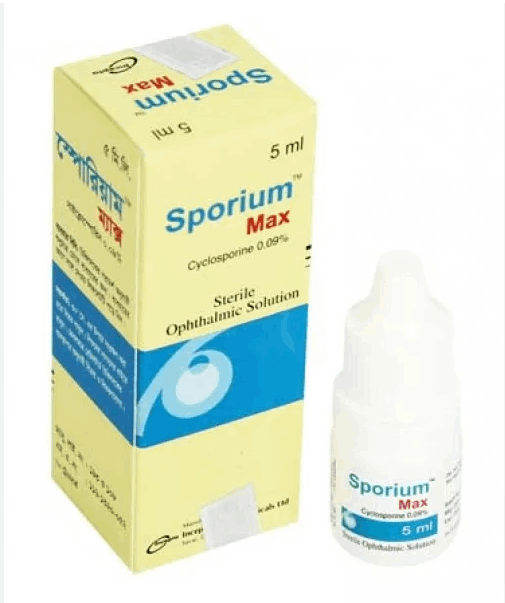
Type:5ml drop
Generic Name:Cyclosporine 0.05% Eye prep
Manufacturer:Incepta Pharmaceuticals Ltd.
Price:৳300.00
Dry eye
Keratoconjuntivitis Sicca 1 drop twice daily approximately 12 hours apart in each eye May be used with artificial tears; allow 15-minute interval between products
<16 years Safety and efficacy not established >16 years Keratoconjuntivitis Sicca 1 drop twice daily approximately 12 hours apart in each eye May be used with artificial tears; allow 15-minute interval between products
Cyclosporine is contraindicated in patients with active ocular infections and in patients with known or suspected hypersensitivity to any of the ingredients in the formulation.
Ciclosporin is a strong immunosuppressant that acts mainly on the helper T-cells. It inhibits the activation of calcineurin and production of interleukin-2, thus reducing cell-mediated immune response. May act as immunomodulator to suppress tear production in keratoconjunctivitis sicca
Cyclosporine eye drop should not be administered while wearing contact lenses. Patients with decreased tear production typically should not wear contact lenses. If contact lenses are worn, they should be removed prior to the administration of this formulation. Lenses may be reinserted 15 minutes following administration of Cyclosporine eye drop. Lactation: Excretion in milk unknown; use with caution
>10% Ocular burning (17%) Frequency Not Defined Conjunctival hyperemia,Discharge,Epiphora,Eye pain,Foreign body sensation,Pruritus
Pregnancy Clinical administration of cyclosporine ophthalmic emulsion 0.05% is not detected systemically following topical ocular administration, and maternal use is not expected to result in fetal exposure to the drug Oral administration of cyclosporine to pregnant rats or rabbits did not produce teratogenicity at clinically relevant doses Lactation Cyclosporine is known to appear in human milk following systemic administration, but presence in human milk following topical treatment has not been investigated; although blood concentrations are undetectable following topical administration of cyclosporine ophthalmic, caution should be exercised when cyclosporine ophthalmic multidose is administered to a nursing woman; the developmental and health benefits of breastfeeding should be considered along with the mother’s clinical need for cyclosporine ophthalmic multidose and potential adverse effects on the breast-fed child from cyclosporine
Increased ciclosporin level by diltiazem, doxycycline, erythromycin, ketoconazole, methylprednisolone (high doses), nicardipine, verapamil, oral contraceptives. Drugs which reduce ciclosporin level are carbamazepine, isoniazid, phenobarbitone, phenytoin and rifampicin. Increased risk of convulsion when used concurrently with high-dose methylprednisolone. Potentially Fatal: Additive nephrotoxicity when used with aminoglycosides, amphotericin B, ciprofloxacin, colchicine, melphalan, co-trimoxazole and NSAIDs.